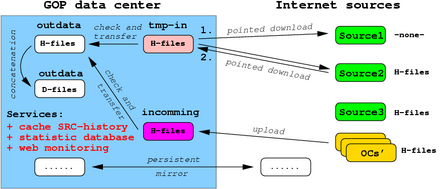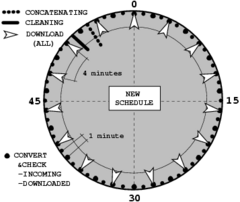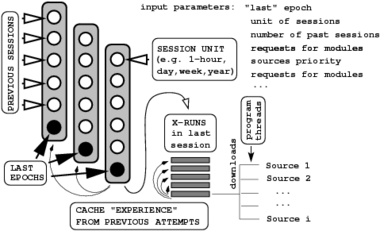|
Geodetic observatory Pecný
|
|
GOP data center for near real-time GPS analysis
The GNSS data center at Geodetic Observatory Pecný (GOP), ftp://ftp.pecny.cz/LDC/ was established in 2000. Since 2001 the data center has been opened for the comunity and since 2002 it has been part of the EUREF Permanent network.
The primary goal of establishing data centre consisted in supporting GOP near real-time GNSS analysis, namely GNSS-meteorology and precise ultra-rapid orbits. For this reason, the data centre provided hourly data, precise products and necessary supporting information such as GPS system, site-logs etc from the beginning. In later years, the data center was enhanced to provide also daily concatenated data for GPS and GLONASS, global broadcast ephemeris and others, data archive for re-processing, data from national stations or from specific project, GOP products etc.
Main data center functions could be summarized as follows:
to pickup the data and products from different FTP sources
to control backward (limited) local completeness for mirrored sites
to manage effective transfer (e.g. complete corrupted files)
to compress and to rename the files unifying the format and filenames
to collect and to manipulate relevant meta-data for GNSS stations, systems, products etc.
to serve for NRT and post-processed GOP products (EUREF, IGS, E-GVAP etc.).
The structure of the data center is briefly described bellow:
- Hourly GNSS RINEX data (nrtdata/<yrdoy/<id>/)
GNSS data are stored only in compressed (and Hatanaka compressed) hourly RINEX files while GPS and GLONASS navigation messages and meteorological information are stored in standard compressed files. The global hourly concatenated GPS and GLONASS data are also provided in the same directory using BRDC name. This data are regularly cleaned after a few days (usually after 4-8 days).
- Daily GNSS RINEX data (data/<year/)
GNSS data are stored only in compressed (and Hatanaka compressed) daily RINEX files. No GPS navigation messages are stored in this directory. Concatenated GPS and GLONASS navigation files can be found in the orbits section.
- Daily GNSS orbits, EOPs and clocks (orbits/<gpsw>/)
The IGS final and rapid GNSS orbits and EOP (Earth orientation parameters) are stored here. These products are persistent to serve mainly for the post-processing analysis. The names and the formats are strictly unified.
- Subdaily GNSS orbits and EOPs (orbits/<gpsw>u/)
The subdaily products like the ultra-rapids (4/day) or hourly (24/day) orbits are stored here. The broadcast orbits concatenated from global data are available in hourly updates and daily concatenations. All the file names and the formats are unified.
- Station meta-data (sit_log/)
Log-files for EUREF, IGS and others stations are updated 2-4 times per day followed with extraction lists. The extracted lists are convenient for the fast and easy routine network control. Each line corresponds to one log-file, thus more lines can be found for a single site. The first column identifies the beginning epoch for the last valid change.
- Bernese supporting files (bswuser/)
Bernese GNSS software (aiub.unibe.ch) supporting files are mirrored twice a day directly from ftp-site of the Centre of Orbit Determination in Europe (CODE) at AIUB.
- IERS bulletins (bul_iep/)
IERS bulletins A and B provide information on the Earth's orientation. Bulletins C and D contain annoncements of the UTC leap seconds, the total differences to TAI atomic time scale and the DUT1 differences (UT1-UTC). All of these are regularly updated.
- GPS system information (gps_sys/)
Actual GPS system status is mirrored directly from the U.S. Naval Observatory (USNO) a few times a day. The NANUs messages (Notice Advisories to NAVSTAR Users), satellite constellations, outage announcements, satellite health code informations and others are available here.
New data center implementation (2002)
In 2002, the data center was completely re-implemented and becamed the official EUREF Permanent Network (EPN) data center.
The main goals to reimplement the data center consisted were:
- to encrease transfer efficiency (a non-redundant traffic loading)
- to decrease storage redundancy
- to encrease the robustness in a single source outage
- to enable easy setup and configuration
- to protect or to decrease low data latency of the hourly files
- to enable dynamic adaptation for the source priority
 The software package developed to operate GOP data center in principle works in three steps:
The software package developed to operate GOP data center in principle works in three steps:
- checking the local data content,
- providing data transfer,
- converting the data.
The software has been written in perl and consists of the following features:
- high modularity
- operating in threads
- geting data by: incoming, downloading, mirroring, unique mirroring
- integrates special procedures for data type (RINEXO, SP3, etc.)
- data concatenation from hourly to daily, from station to global
- monitoring data quality and a archive
- effective and simple configuration
- supporting different projects (anonymous data, password protected data)

 New implementation uses strictly non-redundant data transfer and storage. About 2/3 of the data storage capacity and the traffic loading was spared compared to the previous implementation. Thanks to the modularity, the data fetching, conversion and storage is separated. Different sources (incomming, download, mirror etc) can be simply integrated and since 2004, hourly files from real-time data streams has been implemented. A cascade of collecting procedure thus co-exists, e.g. if real-time data are not available, standard download procedure follows.
New implementation uses strictly non-redundant data transfer and storage. About 2/3 of the data storage capacity and the traffic loading was spared compared to the previous implementation. Thanks to the modularity, the data fetching, conversion and storage is separated. Different sources (incomming, download, mirror etc) can be simply integrated and since 2004, hourly files from real-time data streams has been implemented. A cascade of collecting procedure thus co-exists, e.g. if real-time data are not available, standard download procedure follows.
Every download process is running in a special thread for the data grouped for every single source. The threads are given a limited interval after which the process is stopped. Unfinished data can be completed in a next run, because it is preceeded by a local data center content checking. Separating the download from the data convertion, both processes could be scheduled in different intervals. Downloads are thus started every 4 minutes while converisons every 1 minute for all completed data.
Hourly data latency in the GOP data center for global stations. The delay is calculated as a mean over the last 3 hours.

Hourly data latency in the GOP data center for Europe. The delay is calculated as a mean over the last 3 hours.

Hourly data latency in the GOP data center for central European region. The delay is calculated as a mean over the last 3 hours.
